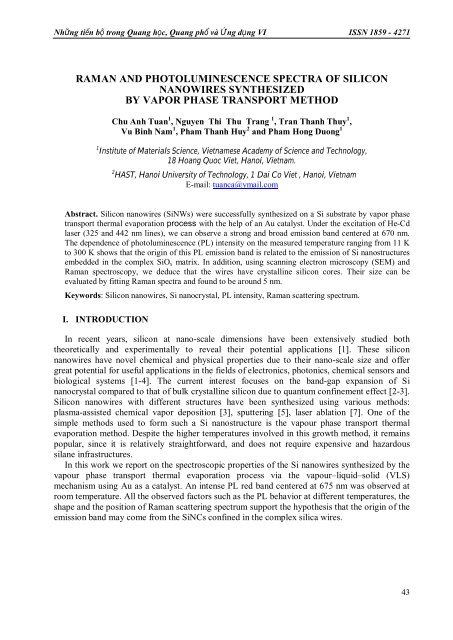Nhng tin b trong Quang hc, Quang ph và ng dng VI ISSN 1859 - 4271
Nhng tin b trong Quang hc, Quang ph và ng dng VI ISSN 1859 - 4271
Nhng tin b trong Quang hc, Quang ph và ng dng VI ISSN 1859 - 4271
Create successful ePaper yourself
Turn your PDF publications into a flip-book with our unique Google optimized e-Paper software.
Nhữ<strong>ng</strong> tiến bộ <stro<strong>ng</strong>>tro<strong>ng</strong></stro<strong>ng</strong>> <stro<strong>ng</strong>>Qua<strong>ng</strong></stro<strong>ng</strong>> học, <stro<strong>ng</strong>>Qua<strong>ng</strong></stro<strong>ng</strong>> <stro<strong>ng</strong>>ph</stro<strong>ng</strong>>ổ và Ứ<strong>ng</strong> dụ<strong>ng</strong> <strong>VI</strong> <strong>ISSN</strong> <strong>1859</strong> - <strong>4271</strong>RAMAN AND PHOTOLUMINESCENCE SPECTRA OF SILICONNANOWIRES SYNTHESIZEDBY VAPOR PHASE TRANSPORT METHODChu Anh Tuan 1 , Nguyen Thi Thu Tra<strong>ng</strong> 1 , Tran Thanh Thuy 1 ,Vu Binh Nam 1 , Pham Thanh Huy 2 and Pham Ho<strong>ng</strong> Duo<strong>ng</strong> 11 Institute of Materials Science, Vietnamese Academy of Science and Technology,18 Hoa<strong>ng</strong> Quoc Viet, Hanoi, Vietnam.2 HAST, Hanoi University of Technology, 1 Dai Co Viet , Hanoi, VietnamE-mail: tuanca@ymail.comAbstract. Silicon nanowires (SiNWs) were successfully synthesized on a Si substrate by vapor <stro<strong>ng</strong>>ph</stro<strong>ng</strong>>asetransport thermal evaporation process with the help of an Au catalyst. Under the excitation of He-Cdlaser (325 and 442 nm lines), we can observe a s<stro<strong>ng</strong>>tro<strong>ng</strong></stro<strong>ng</strong>> and broad emission band centered at 670 nm.The dependence of <stro<strong>ng</strong>>ph</stro<strong>ng</strong>>otoluminescence (PL) intensity on the measured temperature ra<strong>ng</strong>i<strong>ng</strong> from 11 Kto 300 K shows that the origin of this PL emission band is related to the emission of Si nanostructuresembedded in the complex SiO x matrix. In addition, usi<strong>ng</strong> scanni<strong>ng</strong> electron microscopy (SEM) andRaman spectroscopy, we deduce that the wires have crystalline silicon cores. Their size can beevaluated by fit<s<stro<strong>ng</strong>>tro<strong>ng</strong></stro<strong>ng</strong>>>tin</s<stro<strong>ng</strong>>tro<strong>ng</strong></stro<strong>ng</strong>>>g Raman spectra and found to be around 5 nm.Keywords: Silicon nanowires, Si nanocrystal, PL intensity, Raman scatteri<strong>ng</strong> spectrum.I. INTRODUCTIONIn recent years, silicon at nano-scale dimensions have been extensively studied boththeoretically and experimentally to reveal their potential applications [1]. These siliconnanowires have novel chemical and <stro<strong>ng</strong>>ph</stro<strong>ng</strong>>ysical properties due to their nano-scale size and offergreat potential for useful applications in the fields of electronics, <stro<strong>ng</strong>>ph</stro<strong>ng</strong>>otonics, chemical sensors andbiological systems [1-4]. The current interest focuses on the band-gap expansion of Sinanocrystal compared to that of bulk crystalline silicon due to quantum confinement effect [2-3].Silicon nanowires with different structures have been synthesized usi<strong>ng</strong> various methods:plasma-assisted chemical vapor deposition [3], sputteri<strong>ng</strong> [5], laser ablation [7]. One of thesimple methods used to form such a Si nanostructure is the vapour <stro<strong>ng</strong>>ph</stro<strong>ng</strong>>ase transport thermalevaporation method. Despite the higher temperatures involved in this growth method, it remainspopular, since it is relatively straightforward, and does not require expensive and hazardoussilane infrastructures.In this work we report on the spectroscopic properties of the Si nanowires synthesized by thevapour <stro<strong>ng</strong>>ph</stro<strong>ng</strong>>ase transport thermal evaporation process via the vapour–liquid–solid (VLS)mechanism usi<strong>ng</strong> Au as a catalyst. An intense PL red band centered at 675 nm was observed atroom temperature. All the observed factors such as the PL behavior at different temperatures, theshape and the position of Raman scatteri<strong>ng</strong> spectrum support the hypothesis that the origin of theemission band may come from the SiNCs confined in the complex silica wires.43















